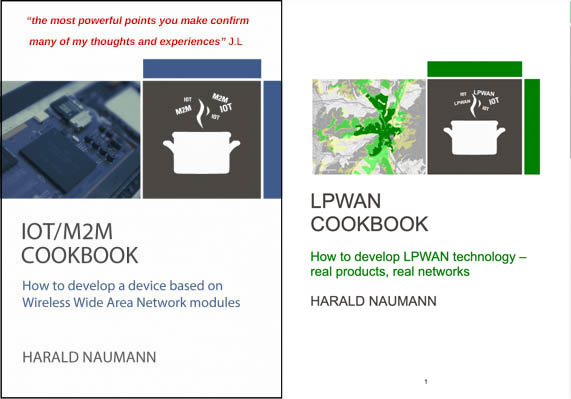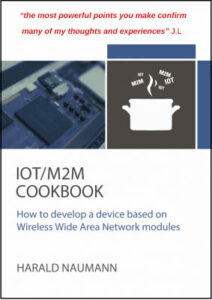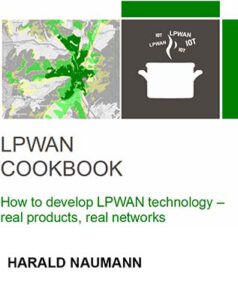
Wireless IoT Cookbooks
Complete guides to wireless antenna design €90 plus V.A.T. Each
Networks evolve, radio design remains key
Twenty-five years ago, there was no “M2M” or “IoT”. Developers used Frequency Shift Keying (FSK) on Private Mobile Radios (PMR) with communication speeds of up to 3600 bits per second. Then came public analogue trunked radios followed by GSM with its Short Message Service (SMS) and Circuit Switched Data (CSD) at 9600 bits per second. Global roaming offering worldwide data communication this was followed by 2.5 and 3G with higher data speeds.
Today, GSM/GPRS is being gradually phased out and, replaced by 4G and 5G technology. GSM networks have been switched off in the USA, Australia, Singapore and many other countries. Devices for pan-European use must therefore support 2G, 3G and 4G, whereas in the USA, NB-IoT or LTE-M is sufficient.
NB-IoT and LTE-M are the new stars in the IoT and M2M firmament and combine classic cellular radio networks with LPWAN. The base station antennas for LTE are also used for NB-IoT and LTE-M. Both techniques have new variable timers, which allow the management of wireless activity and extends the potential operational life of devices to many years without the need for a service visit.
There are different terms used for these new classes of devices and the ways that they communicate, M2M, IoT, IIoT Industry 4.0 and so on. Applications for all of these often use the same wireless technology. The names are not important here because building cost-effective and efficient wireless radios is a common requirement.

The goal of the book is to guide developers from the concept stage of an IoT/M2M device all the way to the final mass-produced product. In many cases, it provides developers with information often omitted in the technical documentation provided by radio module and antenna manufacturers.
The IoT/M2M Cookbook describes in detail how to develop a tracking device based on cellular and Global Navigation Satellite System (GNSS) modules. The navigation system for trucks described in the book uses six different wireless technologies (2G, 3G, GNSS, Classic Bluetooth, Bluetooth Low Energy and NFC) with five different antennas within one enclosure.
The book also covers an inverted F PCB antenna for GSM, NB-IoT and LTE-M and how to redesign it using the ground plain of your PCB and how to encapsulate the whole design in epoxy resin. It also explains how to integrate a chip or PCB antenna with coaxial cable. Some power supply concepts including LT Spice modules for DC/DC regulators and load generator for the 2 Ampere peak currents are included in the book, too.
Common pitfalls are explained, for example the fact that the power down reset is a common fault in designs with cellular modules.
Click here to download an excerpt and a table of contents of the book
Click here for to request a price for your copy of the book
 NB-IoT and LTE-M are the new stars in the IoT firmament and combine classic cellular networks with LPWAN. Both LPWAN technologies feature new variable timers that enable wireless power management and extend the potential life of devices up to 10 years with the original battery. If the network coverage of the public LPWAN is not good enough for you, you have the option to set up your own radio network.
NB-IoT and LTE-M are the new stars in the IoT firmament and combine classic cellular networks with LPWAN. Both LPWAN technologies feature new variable timers that enable wireless power management and extend the potential life of devices up to 10 years with the original battery. If the network coverage of the public LPWAN is not good enough for you, you have the option to set up your own radio network.
The LPWAN cookbook describes how to plan, simulate and test your own private LPWAN.
A detailed explanation of how to develop and test your own LPWA device is given. Antenna designs for NB-IoT/LTE-M and LoRaWAN/Sigfox are shown and explained in simulation and in measurements, the value of software to battery life is discussed.
Another big chapter is the comparison of NB-IoT, LTE-M, LoRaWAN, and Sigfox. Since the updates to the LPWAN Cookbook are free as they are with the IoT/M2M Cookbook, this chapter will be updated at regular intervals. NB-IoT started life with many more features than other LPWANs and new features are added every few months. The LPWAN technology comparison should help shed light on the darkness of the LPWA jungle.
The LPWAN cookbook is intended to help wireless application developers to save time and to provide ideas to inspire the developer through the common experiences that the author has gathered over several years in leading development teams and working with manufacturing and distribution.
Click here to download an excerpt and a table of contents of the book
Click here for to request a price for your copy of the book
Example: how to design a dual F antenna
The IoT M2M Cookbook contains a simulation of a dual F antenna for a range of wireless networks.
The two antenna arms work independently of each other and as a result allow the combination of NB-IoT/LTE-M (SubGHz) with BLE/WiFi or the combination of NB-IoT/LTE-M with GNSS. These combinations are used in low-cost trackers, cellular/BLE gateways or in waterproof sensors.
This antenna design has been customized several times by customers, or by the akorIoT team on behalf of customers.
